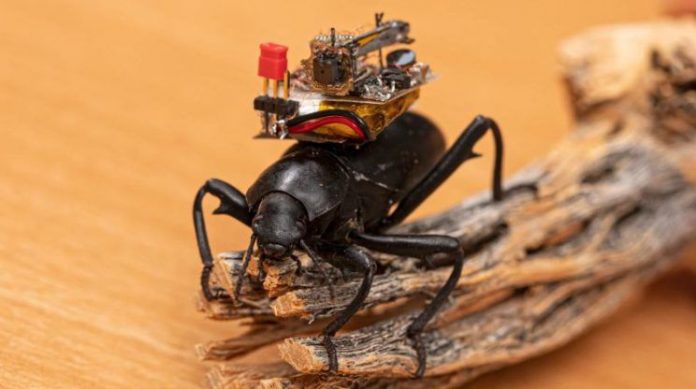It’s a good day to be a tech-loving beetle, as researchers at the University of Washington (UW) have developed a tiny, wireless camera that can be mounted on top of live insects such as beetles and robots of similar size.
The camera can stream video to a smartphone at 1 to 5 frames per second — which, admittedly, isn’t a lot. But that performance becomes much more impressive when you consider that it weighs just 250 milligrams (0.008 ounces) and can pivot 60 degrees (to get wide-angle panorama shots).
BettlePro
“We have created a low-power, low-weight, wireless camera system that can capture a first-person view of what’s happening from an actual live insect or create vision for small robots,” said senior author Shyam Gollakota, a UW associate professor in the Paul G. Allen School of Computer Science & Engineering.
“Vision is so important for communication and for navigation, but it’s extremely challenging to do it at such a small scale. As a result, prior to our work, wireless vision has not been possible for small robots or insects.”
The team mounted the cameras on top of live beetles and insect-sized robots to test their efficiency. The cameras themselves are lightweight but the batteries needed to power them would be much too large for the insects to bear, so the team used a different approach.
Vision is inherently energy-hungry. Flies, the authors note, use between 10% and 20% “of their resting energy just to power their brains, most of which is devoted to visual processing”. In order to reduce this strain, their eyes have a central area of high-focus and an external area of low-focus. To see clearly, they need to turn their heads in the direction they want to see; the outer area then helps them keep watch for predators, but doesn’t produce a high-quality image.
This setup also means that their brains have to use much less energy to process the incoming images.
To mimic this approach, the team installed a tiny, ultra-low-power black-and-white camera on a mechanical arm that they can sweep across the field of view. The arm moves when a high voltage is applied (which bends the material). Unless more power is applied, the arm stays in place for about a minute and eventually relaxes back into its original position
“One advantage to being able to move the camera is that you can get a wide-angle view of what’s happening without consuming a huge amount of power,” said co-lead author Vikram Iyer, a UW doctoral student in electrical and computer engineering.
“We can track a moving object without having to spend the energy to move a whole robot. These images are also at a higher resolution than if we used a wide-angle lens, which would create an image with the same number of pixels divided up over a much larger area.”
The whole setup can be controlled with a smartphone via Bluetooth from a distance of up to 120 meters away.
The beetles chosen to test this camera were a death-feigning beetle and a Pinacate beetle, as there was evidence they could bear weights of around half a gram. The team ensured the device didn’t impede the insects’ motions, and let them loose on gravel, on a slope, and on a tree. The beetles successfully navigated them all, even managing to climb the tree. The authors note that the beetles lived for at least a year after the experiment.
“We added a small accelerometer to our system to be able to detect when the beetle moves. Then it only captures images during that time,” Iyer said.
“If the camera is just continuously streaming without this accelerometer, we could record one to two hours before the battery died. With the accelerometer, we could record for six hours or more, depending on the beetle’s activity level.”
The robot used in the tests is the smallest power-autonomous terrestrial robot with wireless vision, according to the paper. It uses vibrations to move (which makes it very energy-efficient). While the setup worked, the vibrations distorted the overall image, so the team had the robot make a short stop, take a picture, and resume moving. In this mode, the robot managed 2 to 3 centimeters per second and a camera battery life of around 90 minutes.
Applications for tiny cameras abound. It’s the first time we’ve been able to have direct footage from the back of an insect, and the camera’s diminutive size means it can go where no other similar device has in the past.
But the team is particularly worried about privacy concerns. They hope that by introducing the public to their creation, “people can start coming up with solutions to address them”.
The paper “Wireless steerable vision for live insects and insect-scale robots,” has been published in the journal Science Robotics.





























